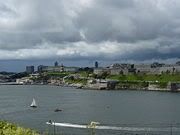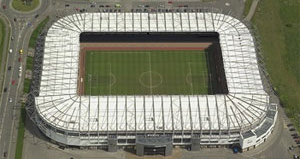Zapata
Zapata is the largest city and administrative headquarters of Green Island, a semi-autonomous entity under the jurisdiction of Candelaria And Marquez. The modern city's borders encompass approximately 75% of the island's population. The original town of Zapateros was founded by Spanish fishermen c.1795, on the Río del Concepto, and quickly became known for its wealth of cobblers, from whom it gained its name. In the 1840s, Green Island became the scene of some of the heaviest conflict between new British settlers and the pre-established Hispanic colonists. The English-speakers were soon victorious, with the island becoming one of the few examples in the Candelarias where the denizens of its towns were almost entirely killed or forced out. Subsequently, the town's name was changed to Queen's Town, and later Riverton; but the usual contraction of the original name remained popular and the rapidly-developing city was officially re-named Zapata in 1903. Like many Candelarias cities, Zapata's success was built on its status as a major port, and this still holds true today. Unlike most of its cousins on the two larger islands, Zapata largely ignored the financial benefits of national and international shipping by focusing on fishing. As the home of the Republic's fishing industry, Zapata is the base of operations of at least 70% of the country's trawlers and trawlermen, and it remains the city's largest employer. Many other small cottage industries contribute to the city's economy, Zapata having failed to follow most large Candelarias cities in embracing the service sector. Given the rural status of the east of the island, it is unsurprising that meat packing and other agricultural activities also employ large portions of the workforce, as does tourism both from the Candelarias and abroad. In 1959, the numerous local councils of Green Island led the Outliers in declaring independence from the Republic, a move that helped initiate the Civil War. As with the other smaller islands of the Candelarias however, Green was largely untouched by the conflict, quickly establishing its own government, based inevitably in Zapata. The new Prime Minister, Roland Compton, led the way in attempting to create a constitution for a Federal Republic of the Outliers; and while the FRO was never formed and Green was reintegrated into the Republic of Candelaria And Marquez, the island's government has always maintained a greater degree of fiscal independence than other cities, regions and islands in C&M. Successive island governments of all parties and political persuasions have made retaining Green's particular way of life a major plank of their administration, including artificially limiting non-white immigration. Zapata indeed has always been once of the most 'Anglo' of large Candelarias cities, with a higher proportion of its denizens claiming British ancestry than any other large settlement in the islands. Though one of the most staunchly pro-Unionist Party cities in the country (despite the victory of former Modern Liberal Party Finance Minister, Charity Morini, at the last elections), far-right parties have always polled well in Zapata; the modern Association of Nationalist Parties banner organisation having four members in the Island Senate. The notorious white supremacist Shoemaker Club was formed in the city in the 1930s, and retained links with major politicians and public figures on the islands, of all political leanings, until relatively recently. Besides longer-standing Italian and French populations; the recently-established Chinese community supplies the largest non-white group in the city. Also, and despite the island's - and the Candelarias' - traditional belligerence towards them, Zapata is home to the largest ethnic Rushmori community outside of Albrecht. Football</div></div>Zapata's first popular team, Riverton Olympic, evolved from an athletics club in the early 1900s. It remained an amateur entity, and still does today though it has since relocated to the nearby town of Korslund. Zapata United FC was formed implicitly for the professional league in 1944, but gained only a modest if passionate fan following and was wound up in 1973. Not until 1986 were Green Island Zapata FC formed, the club enjoying modest success before gaining promotion into Division One of the CMSC for the 1994/95 season and their finest hour in gaining the league title in 1998/99. They have since endured a period as the archetypal 'yo-yo club', but took a major step forward in the XXV season. With players the quality of C&M star Ben Head, attacking midfielder Roger Zetaback of the Elves Security Forces and talented, home-grown youngsters including Brayton Desideri, Stuart Vidakovic and Ben Young; manager Hane Davies steered them into an unexpected title challenging position in the season following promotion via the play-offs. They would ultimately finish six points off champions Albrecht FC, but won the CMS Cup. Zetaback would go on to be voted the league's Foreigner of the Year, while Vidakovic claimed the league's Golden Boot.
TwinningZapata is officially twinned with Bassabook, Zwangzug. A bookshop owner and scout master, Donald Ablett, is President of the Twinning Association. PronunciationAn understanding of the distinctive accent long held in the city of Zapata, can be gleaned from the popular Candelarias children's song below; originally based on the general theme of the Pat-A-Cake nursery rhyme. ZAH-P’-T’, Men’ m’m’ shoen, Nell on n’n’ heel, The rhyme is accompanied by enthusiastic miming. Subsequent verses, both chanted and mimed with increasing force and rapidity, take us on a tour of the city's other occupations which for reasons of rhyming couplets include a surgeon, bean grower, ladder-maker, waste management official, psychologist and the much-loved if highly ungrammatical bit about an executioner. By verse ten, the whole class have usually collapsed in a giggling, bruised mess. The song is believed to have been constructed as a party game during the great chair makers' strike of 1910. |
|||||||||||||



